

Free Wills Month. Kidney Research UK - Kidney Research UK - Kidney Research UK. Summary These pages cover the assessment and preparation for kidney donation.

At the end of these pages are many informative and useful links. Why do I want to be a donor? There must be a powerful reason why you wish to donate, and this is usually because of your concern for your relative, spouse, partner or friend who is in need of a kidney transplant. Parents consider themselves as natural donors as an extension of their role. However, others such as cousins, aunts and uncles, and even friends, are increasingly offering to be kidney donors. The act of donation should be undertaken without any pressure or coercion. All potential donors have the option of pulling out of the donation process up until the very day of surgery.
Things to think about before considering kidney donation: Donating a kidney involves personal inconvenience, time off work and time away from the family. What are the risks and benefits to you if you donate? Food labelling. Nutrition labels can help you choose between products and keep a check on the amount of foods you're eating that are high in fat, salt and added sugars.
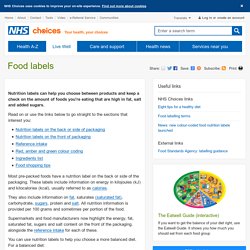
Read on or use the links below to go straight to the sections that interest you: Most pre-packed foods have a nutrition label on the back or side of the packaging. These labels include information on energy in kilojoules (kJ) and kilocalories (kcal), usually referred to as calories. They also include information on fat, saturates (saturated fat), carbohydrate, sugars, protein and salt.
All nutrition information is provided per 100 grams and sometimes per portion of the food. Supermarkets and food manufacturers now highlight the energy, fat, saturated fat, sugars and salt content on the front of the packaging, alongside the reference intake for each of these. You can use nutrition labels to help you choose a more balanced diet. Creatinine: Common Questions. Pee Tracker - Your daily Urine and Hydra Log on the App Store. Oedema. Oedema is a build up of fluid in the body which causes the affected tissue to become swollen.
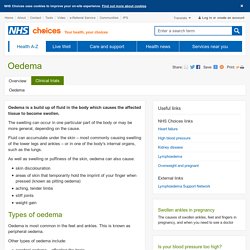
The swelling can occur in one particular part of the body or may be more general, depending on the cause. Fluid can accumulate under the skin – most commonly causing swelling of the lower legs and ankles – or in one of the body's internal organs, such as the lungs. As well as swelling or puffiness of the skin, oedema can also cause: skin discolouration areas of skin that temporarily hold the imprint of your finger when pressed (known as pitting oedema) aching, tender limbs stiff joints weight gain Types of oedema Oedema is most common in the feet and ankles.
Other types of oedema include: cerebral oedema – affecting the brain pulmonary oedema – affecting the lungs macular oedema – affecting the eyes. Medscape: Medscape Access. Hong Kong Kidney Foundation. Reversing Type 2 Diabetes. Type 2 diabetes can be reversed (put into remission) Reversing diabetes is a term that usually refers to a significant long-term improvement in insulin sensitivity in people with type 2 diabetes.

People with type 2 diabetes that are able to get their HbA1c below 42 mmol/mol (6%) without taking diabetes medication are said to have reversed or resolved their diabetes. This also known as putting diabetes into remission. Loss of body weight can be particularly beneficial in helping to reverse the progression of diabetes. Urinalysis: how to interpret results. In this article Steps to follow when carrying out urine testingWhat to look out forCommon causes of abnormality Author Ann Yates is director of continence services, Cardiff and Vale University Health Board.
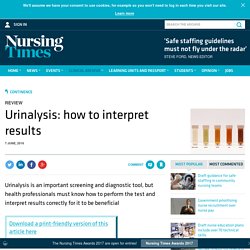
Abstract Yates A (2016) Urinalysis: how to interpret results. Urine 24-hour volume: MedlinePlus Medical Encyclopedia. 30+ Healthy Low Potassium Farmer’s Market Food Finds - DaVita. Whether you’re avoiding high-potassium foods or adding potassium-rich foods, the farmer’s market offers some good foods to eat for kidney health.
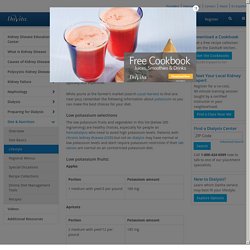
Farmer’s market foods are also eco-friendly and typically less expensive. While you’re at the farmer’s market (search Local Harvest to find one near you), remember the following information about potassium so you can make the best choices for your diet. Low potassium selections The low potassium fruits and vegetables in this list (below 200 mg/serving) are healthy choices, especially for people on hemodialysis who need to avoid high potassium levels. Food labelling. Northwest Kidney Centers. Normal and Diabetic Blood Sugar Level Ranges - Blood Sugar Levels for Diabetes. Blood glucose ranges for adults and children differ slightly Understanding blood glucose level ranges can be a key part of diabetes self-management.
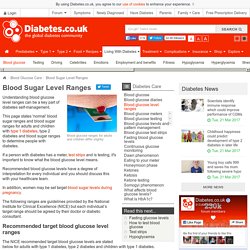
This page states 'normal' blood sugar ranges and blood sugar ranges for adults and children with type 1 diabetes, type 2 diabetes and blood sugar ranges to determine people with diabetes. If a person with diabetes has a meter, test strips and is testing, it's important to know what the blood glucose level means. Recommended blood glucose levels have a degree of interpretation for every individual and you should discuss this with your healthcare team. In addition, women may be set target blood sugar levels during pregnancy. The following ranges are guidelines provided by the National Institute for Clinical Excellence (NICE) but each individual’s target range should be agreed by their doctor or diabetic consultant.
Recommended target blood glucose level ranges The table provides general guidance.